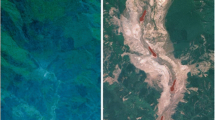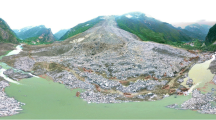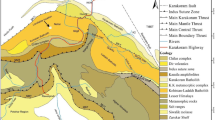Abstract
The large, deep-seated Rosone landslide (Western Italian Alps) has been known since the beginning of the twentieth century as an active phenomenon characterized by a slow but constant evolution. Its possible evolution, in terms of a catastrophic rock avalanche, could have serious consequences on several elements at risk, including a hydroelectric power plant. Runout estimates are needed to identify the potential impact on the territory of such an event and, when possible, to minimize hazard areas. This article analyses the evolution of three potential rock avalanche scenarios, with decreasing probability of occurrence and increasing impact on land planning. A comparison between runout results obtained by other authors and some new analyses that have been carried out with the three-dimensional continuum mechanics-based RASH3D code is made and commented on by highlighting the advantages, but also the limits, of using a more complete tool, such as RASH3D.













Similar content being viewed by others
References
Amatruda G, Campus S, Castelli M, Delle Piane L, Forlati F, Morelli M, Paro L, Piana F, Pirulli M, Polino R, Ramasco M, Scavia C (2004) The Rosone landslide (chapter 5). In: Bonnard CH, Forlati F, Scavia C (eds) “Identification and mitigation of large landslide risks in Europe. Advances in risk assessment”. A.A. Balkema publishers, pp 89–136
Audusse E, Bristeau MO, Perthame BT (2000) Kinetic schemes for Saint-Venant equations with source terms on unstructured grids. Institut National de Recherche en Informatique et en Automatique, Report 3989, LeChesnay, France
Bristeau MO, Coussin B (2001) Boundary conditions for the shallow water equations solved by kinetic schemes. Institut National de Recherche en Informatique et en Automatique, Report 4282, LeChesnay, France
Compagnoni R, Elter G, Lombardo B (1974) Eterogeneità stratigrafica del complesso degli gneiss minuti nel massicci cristallino del Gran Paradiso. Mem Soc Geol It. 13(1):227–239
Delle Piane L, Fontan D, Mancari G (2010) The Rosone landslide (Orco River valley, Western Italian Alps); un updated model. Geogr Fis Dinam Quat 33:165–177
Dutto F, Friz E (1989) Ricerche sul comportamento di grandi france nelle alpi, Rapporto interno CNR-IRPI/ISMES Febbraio, p 16
Enel.Hydro (2001) Attività di progettazione, fornitura ed installazione di un sistema di monitoraggio integrato del movimento franoso di Rosone - Scenari di rischio - Valutazione dell’area di invasione conseguente all’ipotetico collasso della frana come valanga di roccia e definizione dei livelli di soglia e delle procedure di allertamento. Internal Report Prog. ISMES 2338, Doc. RAT-ISMES-1432/2001
Fell R, Glastonbury J, Hunter G (2007) Rapid landslides: the importance of understanding mechanisms and rupture surface mechanics. Quat J Eng Geol Hydrogeol 40:9–27
Forlati F, Ramasco M, Susella G, Barla G, Marino M, Mortara G (1991) La deformazione gravitativa di Rosone. Un approccio conoscitivo per la definizione di una metodologia di studio, In: Proc. Conference on “Fenomeni franosi. Interventi di salvaguardia del territorio e proposte per la pianificazione urbanistica”, Studi Trentini di Scienze Naturali, Acta Geologica 68:71–108 (in Italian)
Forlati F, Gioda G, Scavia C (2001) Finite element analysis of a deep-seated slope deformation. Rock Mech Rock Eng 34:135–159
Friz E, Pinelli PF (1993) Ricerche sull’area di invasione di valanghe di roccia. Proc. National Congress ‘‘Fenomeni Franosi’’, Riva del Garda, Italy. Studi Trentini di Scienze Naturali, Acta Geologica 68:55–65 (in Italian)
Hadley JB (1964) Landslides and related phenomena accompanying the Hebgen Lake earthquake of August 17, 1959. U.S. Geol Surv Prof Paper 435:107–138
Heim A (1932) Bergsturz and Menschenleben. Fretz and Wasmuth Verlag A.G, Zürich
Hsu KJ (1975) Catastrophic debris streams (sturzstroms) generated by rockfalls. Bull Geol Soc Am 86:129–140
Hungr O (1995) A model for the runout analysis of rapid flow slides, debris flows, and avalanches. Can Geotech J 32:610–623
Hungr O, Evans SG (1996) Rock avalanche runout prediction using a dynamic model. In: Senneset K (ed) Proceedings of the 7th International Symposium on Landslides, Trondheim. A.A. Balkema, Rotterdam, pp 233–238
Hungr O, Evans SG, Bovis M, Hutchinson JN (2001) Review of the classification of landslides of the flow type. Environ Eng Geosci 7:221–238
Hungr O (2002) Rock avalanche motion: process and modelling, In NATO advanced research workshop massive rock slope failure: new model of hazard assessment, June 16-21, Celano, Italy
Hungr O, Evans SG (2004) Entrainment of debris in rock avalanches: an analysis of a long runout mechanism. Geol Soc Am Bull 116(9/10):1240–1252
Hungr O (2006) Rock avalanche occurrence, process and modelling. In: Evans SG et al (eds) Landslides from massive rock slope failure, NATO Science Series, Springer 49:243–266
Hutchinson JN (1986) A sliding-consolidation model for flow slides. Can Geotech J 23:115–126
Iverson RM, Denlinger RP (2001) Flow of variably fluidized granular masses across three dimensional terrain—1: coulomb mixture theory. J Geophys Res 106(B1):537–552
Kilburn C, Sorensen SA (1998) Runout lengths of sturzstroms: the control of initial conditions and of fragment dynamics. J Geophys Res 103:17877–17884
Körner HJ (1976) Reichweite un Geschwindigkeit von Berstruzen und fleisscheneelawinen. Rock Mech 8(4):225–256 (in German)
Li T (1983) A mathematical model for predicting the extent of a major rockfall. Zeitsch Geomorph 27:473–482
Luino F, Ramasco M, Susella G (1993) Atlante dei centri abitati instabili piemontesi (classificati ai sensi della L. 9 Luglio 1908 n. 445 e seguenti). CNR I.R.P.I./Regione Piemonte S.P.R.G.M.S., Gruppo Nazionale per la Difesa dalle Catastrofi Ecologiche. 964: Programma Speciale Studio Centri Abitati Instabili
McDougall S, Pirulli M, Hungr O, Scavia C (2008) Advances in landslide continuum dynamic modeling (Special Lecture). In: 10th international symposium on landslides and engineered slopes, Xi’ An, China, 30 June-4 July, pp 835–841
Nicoletti G, Sorriso-Valvo M (1991) Geomorphic control of the shape and mobility of rock avalanches. Geol Soc Am Bull 103:1365–1373
Notti D, Meisina C, Colombo A, Lanteri L, Zucca F (2013a) Studying and monitoring large landslides with persistent scattered data. Ital J Eng Geol Environ Book Series 6:349–360
Notti D, Meisina C, Zucca F, Balduzzi G, Colombo A (2013b) Map numerical modelling of landslides using data from different monitoring systems: the example of Rosone (Western Alps). In: Procs. IAEG XII Congress, Torino September 15–19, 2014, 2:1455–1459
Perla R, Cheng TT, McClung DM (1980) A two-parameter model of snow-avalanche motion. J Glaciol 26(94):197–207
Pirulli M (2004) Numerical analysis of three potential rock avalanches in the Alps. Felsbau 22(2):32–38
Pirulli M (2005) Numerical modelling of landslide runout, a continuum mechanics approach. PhD Thesis, Politecnico di Torino, Torino, Italy
Pirulli M, Mangeney A (2008) Results of back-analysis of the propagation of rock avalanches as a function of the assumed rheology. Rock Mech Rock Eng 41(1):59–84
Pirulli M, Marco F (2010) Description and numerical modelling of the October 2000 Nora debris flow, Northwestern Italian Alps. Can Geotech J 47:135–146
Pisani G, Castelli M, Scavia C (2010) Hydrogeological model and hydraulic behaviour of a large landslide in the Italian Western Alps. Nat Hazards Earth Syst Sci 10:2391–2406
Ramasco M, Stoppa T, Susella G (1989) La deformazione gravitativa profonda di Rosone nella Valle dell’Orco. Bollettino della Società Geologica Italiana 108:401–408
Ramasco M, Troisi C (2003) Grandi fenomeni franosi attivatisi a seguito dell‘evento dell’ottobre 2000. Eventi alluvionali in Piemonte—evento alluvionale regionale del 13-16 ottobre 2000. ARPA Piemonte, Torino, pp 255–309
Revellino P, Hungr O, Guadagno FM, Evans SG (2004) Velocity and runout simulation of destructive debris flows and debris avalanches in pyroclastic deposits, Campania region, Italy. Environ Geol 45:295–311
Rickenmann D, Koch T (1997) Comparison of debris flow modelling approaches, In: Chen CL (ed) Proc. 1st Int. Conf. On Debris Flow Hazards Mitigation: Mechanics, Prediction, and Assessment ASCE, Reston, Va., 576–585
Savage SB, Hutter K (1989) The motion of a finite mass of granular material down a rough incline. J Fluid Mech 199:177–215
Scheidegger A (1973) On the prediction of the reach and velocity of catastrophic landslides. Rock Mech 5:231–236
Sosio R, Crosta GB, Hungr O (2008) Complete dynamic modeling calibration for the Thurwieser rock avalanche (Italian Central Alps). Eng Geol 100(1–2):11–26
Varnes DJ (1978) Slope movement types and processes. In Schuster RJ and Krizek RJ (eds), Landslides, analysis and control: transportation research board, National academy of sciences, Washington, DC., Special Report 176:11–33
Voellmy A (1955) Uber die Zerstorungskraft von Lawinen. Schweizerische Bauzeitung 73:212–285 (in German)
Acknowledgments
The author wishes to thank Dr. Ferruccio Forlati, Dr. Carlo Troisi (Regione Piemonte-Settore Prevenzione Territoriale del Rischio Geologico) and Dr. Alessio Colombo (ARPA Piemonte-Agenzia Regionale per la Protezione Ambientale) for having provided the data concerning the Rosone deep-seated gravitational slope deformation.
Author information
Authors and Affiliations
Corresponding author
Rights and permissions
About this article
Cite this article
Pirulli, M. Numerical Simulation of Possible Evolution Scenarios of the Rosone Deep-Seated Gravitational Slope Deformation (Italian Alps, Piedmont). Rock Mech Rock Eng 49, 2373–2388 (2016). https://doi.org/10.1007/s00603-015-0857-0
Received:
Accepted:
Published:
Issue Date:
DOI: https://doi.org/10.1007/s00603-015-0857-0




